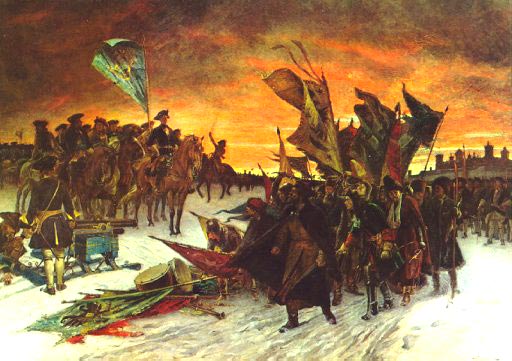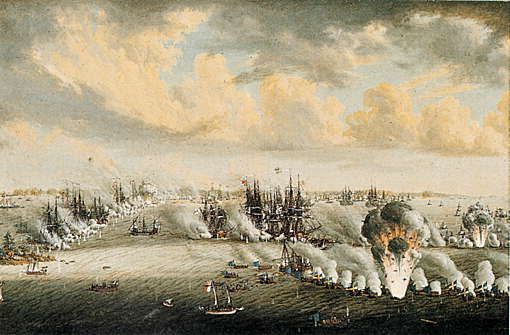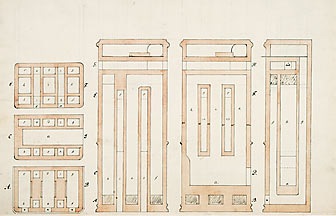
 
................................ |
|
History Selected Battles - Narva - Gadebusch - Svensksund - Revolax - Sveaborg Science - Nickel - Kakelugn Arts - Architechture - Collections |
| HOME | ORIGINS | HISTORY | BIOGRAPHIES | COAT OF ARMS | ABOUT |
|
Cronstedt in History
Members of the Cronstedt family have played important roles in history, influenced the outcome of wars and made significant contributions to the fields of science, art and socio-economic development. Below are brief overviews of selected battles, main discoveries and works of art. The “Biographies” section contains more in-depth information about the people involved and the origins of the family. Selected Battles The Battle of Narva, November 20, 1700 The Battle of Narva was an early battle in the Great Northern War in which a Swedish army under King Charles XII of Sweden defeated the Russian army of Tsar Peter the Great at Narva. It was a stunning Swedish tactical victory. The 8,140 man strong Swedish force under King Charles XII engaged the Russian Army that was besieging the Swedish (now Estonian) city of Narva. The Russian army had great numerical superiority, numbering about 80,000 to 100,000. Baron Carl Cronstedt was commanding the artillery which played a deciding role in the battle. The Swedish Army went into action at noon, protected by an artillery blizzard blowing into the Russian forces. The battle was a great Swedish victory in which Sweden lost only 667 men. After the victory Cronstedt followed the Swedish army through Russia and was captured by the Russians at the battle of Poltava. Cronstedt was released in 1710 in exchange for a Russian artillery captain. Source: Wikipedia 
The Swedish victory at Narva 1700, by Gustaf Cederström 1910 The Battle of Gadebusch, December 20, 1712 “Next to God, we thank Cronstedt and his cannons for the victory” The quote is taken from Feldmarshal Stenbock's letter to the Swedish king after the victory at Gadebusch. The Battle of Gadebusch was Sweden's final great victory in the Great Northern War. It was fought by the Swedes to prevent the loss if the city of Stralsund to Danish and Saxon forces. The Swedish artillery played a decisive role at Gadebusch due to the innovations of its commander, Colonel Carl Cronstedt. At Gadebusch the artillery actually formed a part of the advance guard and first covered the deployment of the remainder of the army and then advanced together with the infantry in order to provide continuous support. These "new" tactics were the result of Cronstedt's improved artillery tactics. Carl Cronstedt is described as one of the most energetic and talented commanders in the history of the Swedish artillery. The Battle of Svensksund, July 9-10, 1790 From 1788 to 1790 Russia was engaged in a war with Sweden, led by the Swedish King Gustav III. Gustav began the war to reclaim the Baltic territories lost to Russia in 1720. The Swedish Army Fleet arrived at Svensksund on July 5th 1790. They were aware of the Russian Galley Fleet following them and the King wanted to engage the Swedish Fleet in a battle immediately. Some of the high ranking officers were against a battle so soon. However, Lieutenant Colonel Carl Olof Cronstedt had just arrived with his Pommern squadron of the Army Fleet, and he supported the King. The morning of the battle, Cronstedt was appointed the new Flag Captain. The Russian navy, commanded by Prince Nassau, had 32 larger and 200 smaller ships. The Swedes, commanded by King Gustav and by Cronstedt, had 200 larger and minor ships. The Russians lost 50 to 60 ships and Swedish losses were 6 ships. After the battle, Cronstedt was promoted to Colonel and was awarded the Swedish Order of the Sword (“riddartecknet av Svärdsordens stora kors”). The Swedish victory at Svensksund radically changed the political situation in Sweden's favor. Despite the fact that the Swedes had started the war, they were able to keep the support of the important European countries of Great Britain and Prussia. The battle of Svensksund is the largest sea battle in the history of the Baltic Sea and the biggest victory of the Swedish navy ever. 
The Battle of Svensksund by Johan Tietrich Schoultz The Battle of Revolax, April 27, 1808 The Finnish War, also know as the War of 1808-09, was fought between Sweden and Russia. Russia was supported by Denmark and Sweden by England. Tsar Alexander I of Russia signed a peace agreement with Napoleon in 1807 which obliged him to attack Sweden unless it broke its relationships with England. The Russian army, superior in strength, invaded Finland, then part of Sweden, in Feburary 1808. The Swedish army suffered great losses as it retreated north through Finland under the command of Wilhelm Maurtiz Klingspor. Count Johan Adam Cronstedt was the commander of the Savolax Brigade during the Swedish retreat. At Revolax, a Russian force under Bulatov had taken up positions and Cronstedt prepared an assault to drive them out. With a force of 1,800 men Cronstedt advanced to the village during the night and attacked in the morning of April 27. The Russians gave fierce resistance as the Swedish advanced, but at the end it was a overwhelming victory for the Swedish forces. The victory at Revolax ended the first Swedish retreat. Sveaborg, May, 1808 At the beginning of the War of 1808-09, Carl Olof Cronstedt was the commandant at Sweden's largest and most important fortress – Sveaborg outside Helsinki. In March 1808, the Russians conquered the city and started to fire at Sveaborg. Due to a severe and cold winter with ice in the Baltic sea, the fortress was cut off from the rest of the world. The Russians, now in control of most of Finland, proposed to negotiate with the commander of the fortress. At first, Cronstedt declined, but on April 6 he granted an armistice and agreed to surrender the fortress unless Sweden came to help before May 3. Back-up did not arrive in time and with the consent of his officers, Cronstedt surrendered the fortress to the Russians. The reasons for Cronstedt's actions at Sveaborg are still debated by historians. Why did Cronstedt, the commander of 1792 naval battle of Svensksund, surrender to the Russians what was at that time called the “Gibralter of the North”. Was it general defeatism, personal bitterness or deception? According to Cronstedt himself, there were too few officers at the Fortress, the troops were not adequately trained and the fortress was not properly fortified. The construction of the fortress was not completed and the Russians attacked from a direction of which the walls of the fortress were not yet properly raised. Scientific Inventions and Discoveries Nickel Nickel was discovered by Baron Axel Fredrik Cronstedt in 1751 in a mineral called niccolite. Cronstedt had expected to extract copper from this mineral but instead got a white metal that he called nickel after the mineral from which it was extracted. The origin of the name "nickel" is a derivative from the German word "kupfernickel", meaning "Devil's Copper" or "St. Nicholas's Copper". Nickel has as a huge importance to society today with its unique chemical, physical, and geological properties. Nickel is used as a protective and ornamental coating for metals, particularly iron and steel, that are susceptible to corrosion. Tiled Stoves (“Kakelugn”) In 1767 the king of Sweden commissioned architect Count Carl Johan Cronstedt and Field Marshal Fabian Wrede to develop a stove that would be as efficient as possible in terms of heating economy. They accomplished the task the same year by an ingenious redesign of the traditional stove, leading the smoke through long flues winding up and down inside the stove. This allowed the stove to absorb and store as much heat as possible from the flue gas and made the stove about eight times as efficient as when the smoke went straight up the chimney. Although initially only wealthy households could afford these new tiled stoves, their technological innovations were applied also in peasant households. The new heating technology enabled the change of the whole residential pattern, including lighting and cleansing, and more rooms could be heated with the same amount of firewood. In addition to social and economical consequences the change had also environmental significance as it saved the forests from excess felling. Tiled stoves were the standard heating device in Swedish town homes up to the early 1900's, and there's been a tiled stove renaissance lately so now they're being produced again. 
Kakelugn sketch by Carl Johan Cronstedt Arts Architecture To be added... Collections To be added... |